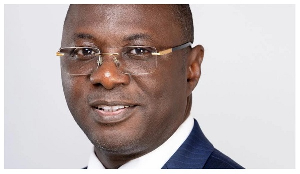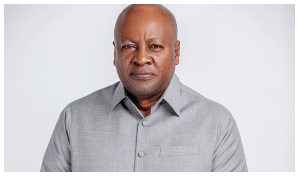Ghana’s economic outlook is not healthy according to the key economic indicators. The most critical indicators are interest rate, inflation, exchange rate and debt accumulation as a percentage of gross domestic product (GDP) which measures the nation’s production output.
The GDP growth rate is expected to fall below the 5% and 6% ideal range for the next two years. Unemployment is forecast to continue to surge above the 7.2% mark by the end of the election year 2020, according to a World Bank report.
The inflation figure (7.8%) is not too much compared to the previous year, but the volatile nature of the exchange rate of the local currency against the major trading currencies is causing prices to increase on the market indirectly.
Currently, Ghanaians spend more than 43% of their total monthly income on food alone. The outlook is close to a Goldilocks economy.
With the novel Coronavirus (COVID-19) outbreak, Ghana’s economy maybe hardly hit due to the impact on her trading partners ie China, Europe and the US, especially because of mass production shutdowns and supply chain disruptions, port closures in China.
The Covid-19 has caused global “twin supply-demand shock”.
Africa is beginning to feel its full impact and plans to control and manage the humanitarian challenges of the virus are underway across the continent of which Ghana is not an exception.
Economically, the effects have already been felt – demand for Ghana’s raw materials and commodities in China has declined and access to industrial components and manufactured goods from China has been hampered.
According to ratings agency, Fitch, the Coronavirus outbreak will have a downside risk for short term growth for sub-Saharan African growth, particularly in Ghana, Angola, Congo, Equatorial Guinea, Zambia, South Africa, Gabon and Nigeria – all countries that export large amounts of commodities to China.
The novel COVID-19 is expected to impact China’s global trade for several months and as China is Ghana’s biggest trading partner, the effects of COVID-19 are already being felt in the area of food supplies to Ghana.
With China having shut down its manufacturing centers and closed its ports, there has been a resultant decrease in supply of commodities as most importers/exporters in China are cancelling orders due to port closures.
OVERVIEW
Over the next few months, the economy of Ghana would experience turbulent times which would lead to very slow GDP growth, increase in inflation, surge in unemployment rate, further depreciation of the cedi and a hike in interest rates. This is as a result of stagnation in domestic revenue mobilization, high interest payment on public debts, over the ceiling expenditure, continuous excessive government borrowing and increase in public service wages and salaries.
These are some very worrying concerns about the economic outlook of Ghana that need the attention of the Government, the economic management team and concerned stakeholders.
The novel COVID-19 may cause Ghana’s GDP growth rate to fall to 2.2% by the end of the year due to a slowdown of both local and global economic activities. GDP growth only respond to economic activities and the lockdown of these buoyant cities like Accra, Kumasi and Tema would cause what I call Economic Activity Disruption.
Ghana’s sovereign credit rating was recently revised to B3 with a negative outlook and this ultimately emanated from the coronavirus outbreak, the vulnerabilities in the economy, especially on Ghana’s credit worthiness, may affect the investor confidence built over the few years.
It is worth noting that Ghana has a track record of slippages during election year and deficiencies in revenue mobilization which always weakens the government’s fiscal target. Furthermore, the government may need approximately GHS78 billion which is 21% of GDP including debt amortization to meet its 2020 financing needs and fortunately the USD3billion Eurobond (4.9%) has provided some inflow to support government revenue needs.
However, the widening of the fiscal deficit means that government may need approximately 3% of GDP more in financing needs to meet its 2020 expenditure.
The government plans to fill the gap in the financing needs for 2020 from the USD 1 billion (1.6% of GDP) from the IMF (Rapid Credit Facility), World Bank’s USD 300 million (0.5% of GDP) and USD 200million (0.3% of GDP) from the Petroleum fund, the remaining would be raised from the local market in government bonds.
Unfortunately for Ghana, its total debt stock is projected to 70% of GDP by the end of year 2020, unemployment to surge to 7.4%, cash deficit to hit 8% of GDP and tax revenue approximately by 35% of target for year 2020. Again, the widening fiscal deficit and the cedi depreciation is going to affect government revenue since the steep cedi depreciation is increasing external debts cost for the country.
Recently, the World Bank cautioned Ghana against excessive borrowing as the total debt stock of the country hit GHS214.9 billion with a revenue mobilization target of GHS67.07 billion, about GHS22.5 billion of which would be used to pay interest on loans alone.
GAME CHANGER FOR THE ECONOMY
The economy can experience a GDP growth rate in the non-oil sector which can translate into a positive macroeconomic growth boom. This can only happen when factors within the business cycle and private sectors of the economy have a change of policy direction.
Government and stakeholders should have a policy review on the following to change the narrative;
Capital availability for the private sector.
Monetary policy rate must translate into Commercial interest rate.
Cumulative data on demand and supply of foreign currency in Ghana.
Policy credibility on incentives to exporters.
Enforcement of policy direction on black market operations in Ghana.
Policy credibility on improving administration.
A strict policy on tax compliance.
Overhaul the tax exemptions regime currently.
UNEMPLOYMENT
A country’s economic outlook cannot be discussed without taking a critical look at the unemployment situation since it’s a component of determining the growth in economic development.
The more employment the people get, the better and wider the tax revenue to be collected. The unemployment rate will average 7.4% in 2020 due to the job losses in the financial sector clean up, the unresolved Menzgold saga and the contraction in the private sector due to lack of cheap funds for SMEs.The reality is that some people have been out of work due to the crises in the banking sector and that they’ll never be able to return to the high-paying jobs they used to have. As a result, structural unemployment would increase.
The real unemployment rate includes the graduate, unskilled, underemployed, the marginally attached, and discouraged workers.
INFLATION
Inflation is a critical indicator in discussing the economic outlook of any country since it is a measure of prices of goods and services. It helps to measure the affordability of prices of both imported and local products and gives a sense of the living standard of the people in the country.
Currently, the single-digit inflation of 7.8% doesn’t translate into the prices of goods and services on the market and the reason is simple; the consumer price index (CPI).
If the goods and services used are not the commonly and regularly consumed products of the majority of the citizens, the inflation figure would be small but the prices of goods and services in the market would keep surging as is the case of Ghana. Inflation is expected to average 9.8% in 2020 and rise to 10.5% in 2021 and 2022. The core inflation rate strips out those volatile gas and food prices.
INTEREST RATES
The Monetary Policy Committee (MPC) of the Bank of Ghana has reduced the policy rate from 16% to 14.5% at its last MPC meeting in the wake of COVID-19 and its impact on people and businesses.
It doesn’t expect to increase the interest rate, but the current prevailing economic happening may force the MPC to adjust upward the policy rate to match the demand and supply of funds and also the mechanism used to stabilize the depreciating currency.
Interest rates at the commercial banks are still very high, even though, the policy rate has been kept low for close to two years. The simple reason why the low policy rate cannot translate into the rate quoted on the commercial market is high cost of funds for the banks, huge non-performing loans and very unstable business environment for the private sector with power outages as a contributing factor.
Unfortunately, the Central bank is more concerned about preventing high inflation rate than promoting growth within the market space. In fact, the Bank of Ghana sees inflation as a threat especially in the coming years.
The slow economic growth and macro impact in the lives of the people is the result of very high-interest rates, lack of availability and access to funds for the private sector to thrive and expand so it can employ more.
DEBT & GOVERNMENT BORROWINGS
Ghana’s total public debt increased to GH?224.9 billion in 2019. As a percentage of GDP, the total public debt is now 63.1% of the rebased GDP in 2019. The bulk of the public debt, totaling GH?188.8 billion (85.3%) was incurred between 2013 and 2019. Of this amount, GH?86.3 billion (38.2%) was incurred in the 4-year period of 2013-2016 and GH?102.5 billion (47.1%) in the 3-year period of 2017-2019 and a total of GH?16.7 billion (8% of the total debt) was advanced towards the cleaning up of the financial sector, which the Bank of Ghana classifies as financial sector resolution bond.
In February this year, the government issued another US$3 billion Eurobond to support its budget for infrastructure, restructuring of the energy and financial services sector, and a liability management exercise (Min. of Finance, 2020). This brought the total public debt stock to GH?234.0 billion at the end of February 2020.
Total domestic debt stood at GH?105.6 billion (49.6% of total public debt) as at the end of December 2019. The bulk of the total domestic debt amounting to GH?84.5 billion (82.1%) was contracted after 2012, of which GH?35 billion (34.0%) was incurred in 2013-2016 and GH?49.5 billion (48.1%) in 2017-2019 (Table 1). The banking sector held about 44.7% of the total domestic debt stock in 2018, showing a significant increase from the 35.5% share in 2017 due to the issuance of stocks to support the bailout of the financial sector. Holdings of domestic bond by foreigners saw a drop from 38.6% in 2017 to 30.1% in 2018 (GoG, March 2019).
Total external debt as at end of year 2019 was GHS111.9 billion (US$20.3 billion) in 2019, (52.1% of the total public debt). As a percentage of GDP, Ghana’s external debt is 32.4%. The bulk of the external debt, amounting to GH?94.3 billion (84.3%), was incurred between 2013 and 2019 (Table 1) with a significant portion raised through the issuance of Eurobonds.
TAX AND REVENUE
One obvious area of under-performance of successive governments is taxation which is immensely important to national development and a key source of sustainable revenue.
While some may have praised the government on the growth in the economy, the reality is that the living standard of the ordinary Ghanaian has not improved, the reason being that economic growth and rebased GDP does not guarantee economic well-being of the people.
In analyzing economic performance, one critical thing to consider is the tax to GDP ratio of the country i.e. the amount of tax collection to the nominal GDP. According to Heritage Foundation data and OECD, Ghana’s tax to GDP is around 11.9% as at 2019, which is low as compared to the highest of 14.1% in 2017 and the lowest being 7.8% in 2000. This is an area that needs a lot more work to be done for government to be able to invest more into capital projects.
The persistent shortfalls in tax revenue collections is a key reason why the government continues to borrow excessively and it’s not sustainable for a near Highly Indebted Poor Country (HIPC) country like Ghana.
CURRENCY AND EXCHANGE RATE MANAGEMENT
The depreciation of the domestic currency, the cedi, against major trading currencies is one of the key indicators you would want to look at when discussing the economic outlook of Ghana especially since it plays a key role in the rising public debt. The exchange rate of the cedi to the United States dollar witnessed a continuous depreciation since the re-denomination of the currency.
The cedi has since experienced some significant exchange rate depreciation sharply under the combined effect of the widening trade deficit and the terms of trade shock due to poor import duty management, hike in black market operations, repatriation of profit by most multinational companies ie. MTN, and some of the tier-one banks.
The exchange rate stabilized in the early part of 2017, recording just depreciation of 4.9% against the US dollar. The cedi however recorded a cumulative depreciation of 8.4 percent against the US dollar by the end of 2018, driven largely by domestic demand pressures and external factors, particularly, the strengthening of the US dollar and rising yields of US Treasury instruments, the effects of the US tightened monetary policy and the rise in interest rates. During the first quarter of 2019, the cedi again came under pressure, driven largely by;
(i) Seasonal demand pressures that recurred in the first quarter of the year resulting from foreign exchange demand by importers and corporate institutions to repatriate profits and dividends,
(ii) Sentiments over Ghana’s economic outlook following the completion of the IMF Extended Credit Facility support program fueled pressures on the foreign exchange market. The interplay of these factors, according to Bank of Ghana resulted in a depreciation of the cedi by 8% at the peak of the crisis in March 2019.
By end of 2019, the cedi-dollar exchange rate had increased to 5.53, reflecting a depreciation of 12.9% in the year. In dollar terms, Ghana’s external debt increased from US$4.0 billion in 2008 to US$20.3 billion in 2019. In cedi terms, however, the external debt increased from GH?4.9 billion in 2008 to GH?111.9 billion in 2019, driven by the cedi-dollar exchange rate which dropped from 1.22 in 2008 to 5.33 in 2019, indicating that the cedi depreciated by 77.1% over the period. Thus, anytime the cedi depreciates, the country’s external debt and debt payments in cedis increase by the size of the depreciation.
(iii) Black market operations and lack of adequate data on dollars in circulation at each point in time.
(iv) Huge importation of goods and services into the country without proper forex management regime within the commercial banking space.
(v) Again, crude oil importation, financial conditions on the global market, and other factors within the fiscal management space also influence the cedi depreciation.
(vi) Interest rate/coupon rate differentials on borrowed funds when it’s time to payback also puts some significant demand pressure on the US Dollar
Some of the pressure appears to be largely self-inflicted and coming from deliberate fiscal under-reporting, using the little accumulated reserves to shore up and stabilize the local currency and reliance on external financing coupled with monetary policy.
For example, instead of monetary policy increasing the policy rate in 2019, Bank of Ghana continued to maintain the policy rate at 16% and instead used more of its reserves to intervene in the foreign exchange market to reduce the pressures. This is unsustainable and not a good medium to long term measure.
HOW IT AFFECTS YOU
Ghana’s 2020 economic outlook shows very unstable micro-economic indicators which has a direct and indirect impact on the macro i.e. the living standard and job sustainability and security for the people. The current situation in which Ghana finds itself leaves everyone in the country to be worried.
From the outlook, Ghana will experience subdued economic growth, although HIPC is unlikely. The effects of the government’s appetite for excessive borrowing, over the ceiling expenditure both budgeted and off the budget, interest payment on loans and employee salaries and wages has left no room within the fiscal space to allow for capital expenditure and developmental projects that would boost economic growth.
It is unfortunate that the government boasts GDP growth of 6.3%, but about 4.5% of this growth happens in the oil sector which only employs very specialized and skilled personnel leaving the real sector with just less than 2% growth. The real sector of the economy is where growth is needed to create the jobs for the graduate, skilled, unskilled, and master craftsman.
These have led to increase in unemployment and most companies are concerned about the uncertainty in the economy resulting from the upcoming elections and the skyrocketing debt profile of Ghana.
The thing to do is to stay focused on your financial well-being. Continue to improve yourself, start a business, and chart a clear course for your career in the fastest-growing industries like agriculture. All in all, an excellent time to reduce debt, build up your savings and invest more, and increase your wealth.
–
The Author, Jerry J. Afolabi, is a Financial & Economic expert.
Click to view details



Opinions of Sunday, 26 April 2020
Columnist: Jerry J. Afolabi



















